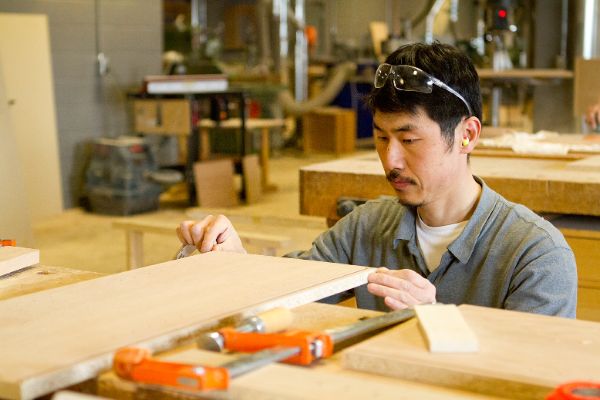On this page:
Overview
Learn to build and repair custom or production-type fixtures and furniture made of wood or wood substitutes with manual and CNC machinery.
As a cabinetmaker, you will build wood units, create detailed drawings, make layouts and patterns, and set up and operate woodworking equipment before cutting, shaping, moulding and assembling components. During assembly, you will use glue, clamps, dowels, nails and screws to secure pieces together. You will also apply veneer, finishing products or apply plastic laminates.
During your career, you'll estimate materials, select woods or other materials and consult with customers on projects. With furniture, you may do refinishing or restoration work and installations of cabinetry and millwork. You will use a variety of tools, including manual or hand tools, as well as Computer Numerical Controlled (CNC) equipment.
Cabinetmakers are skilled tradespeople with a knack for creativity, are self-motivated and enjoy working collaboratively with others.
To thrive in this career, it is important to have the following traits:
- the ability to understand and interpret drawings, blueprints, and other specifications to visualize the final product
- creativity to come up with unique designs or solutions
- the ability to adapt to unexpected challenges and solve problems
- excellent communication skills and a dedication to providing excellent customer service
- attention to detail and a desire to produce high-quality, precise work
- good eyesight to identify surface imperfections and select suitable woods
- good hand-eye coordination and manual dexterity to work with precision tools
- a strong commitment to maintaining a safe and healthy work environment.
Upon successfully completing the required working hours and apprenticeship education periods, graduates will be awarded an advanced diploma in addition to journeyperson status by Alberta’s Apprenticeship and Industry Training.
Cabinetmaking is a Red Seal Endorsed trade – a recognizable standard that allows tradespeople to work across Canada.
Careers and opportunities
Our graduates may work in the following occupations. Some careers require additional experience and education.
Associated National Occupational Classification (NOC) codes: 72311, 92022, 94124, 94210, 94211.
Apprenticeship training
The term of apprenticeship for a cabinetmaker is four years (four 12-month periods), including a minimum of 1360 hours of on-the-job training and eight weeks of classroom instruction at SAIT each year.
Year 1 | Period 1
You will start by learning standard workplace safety and building materials. You will then learn about wood properties and manufacturing, tools, machines and equipment, shop and residential drawing and interpretation.
Training length: 8 weeks
Year 2 | Period 2
You will then learn materials and hardware, equipment, machine use, assembly, procedures, wood finishing, drawing interpretation and material calculations.
Training length: 8 weeks
Year 3 | Period 3
You will then learn materials, packing, shipping and stairs, design theory, shop procedures, machines and equipment procedures, commercial drawings, and stair and industry-related calculations.
Training length: 8 weeks
Year 4 | Period 4
You will learn business practices and workplace coaching skills, wood finishing, drawing interpretation and shop drawings, construction of industry projects, job costing and material estimating.
Training length: 8 weeks
Apprenticeship education performance
You must pass each section of the course and the AIT exam to succeed in apprenticeship education.
The passing grade for each period is no less than 50% in each course with no less than a 65% average overall. A passing mark on each provincial exam and the interprovincial qualification (Red Seal Exam) is 70%.
View Alberta's Apprenticeship and Industry Training procedures
Training pathways
You can earn your journeyperson designation in the following way.
The traditional training pathway begins with finding a job with an employer willing to indenture you as an apprentice. Once you are an apprentice, you will alternate between on-the-job training and educational periods.
You must apply for an apprenticeship through Alberta Apprenticeship and Industry Training before attending your first education period at SAIT.

Pre-employment pathway
SAIT’s Pre-employment Cabinetmaker program prepares you to enter into an apprenticeship with hands-on skills. Upon successfully completing the program, you’ll qualify to challenge the first-year Cabinetmaker apprenticeship exam.
Pre-employment CabinetmakerAdmission requirements
To enter an apprenticeship, you must have the educational qualifications required or recommended education for the trade to which you apply.
Entrance requirements are monitored and set by Alberta Apprenticeship and Industry Training.
Minimum requirements
Successful completion of the following courses:
- English 10-2
- Math 10-3
OR
A pass mark in all five Canadian General Educational Development (GED) tests
OR
Alberta Apprenticeship and Industry Training Entrance Exam.
Recommended requirements
Apprentices with an Alberta High School Diploma that includes the following courses:
- English 30-2
- Math 30-3
- Physics 20 OR Chemistry 20 OR Science 20
- Related career and technology studies (CTS) courses

MyTradeSecrets
Once you have begun working as an apprentice, you can attend SAIT to complete your technical training.
You'll register for technical training at SAIT on MyTradeSecrets or you can register by phone.
How to registerAvailable intakes
Costs
2024/25 tuition and fees
The following costs are effective as of July 1, 2024.
Books or modules, along with other items for classes, are approximately $600 per period.
It's recommended you don't purchase books or modules ahead of time as they might be outdated by the time you attend classes, and they cannot be returned to the Bookstore.
Personal protective equipment (PPE) will be required for the program, which may be an additional cost to apprentices.
2023/24 tuition and fees
The following costs are effective until June 30, 2023.

Funding options for apprentices
Apprentices get to learn while they earn, but there are still costs to consider. Many resources are available at SAIT and federally to help support apprentices.
Financial aidInformation sessions
Prepare for a strong start in your chosen program or get the details you need to decide your future path.
Our expert staff and faculty are ready to answer your questions and provide information about the following:
- What sets SAIT apart
- An introduction to the program and area of study
- Admission requirements
- Future career paths
- Information on the earning potential and graduate employment rates.
Contact
Have more questions?
Apprenticeship training and registration
Apprenticeship and Industry Training Client Services
